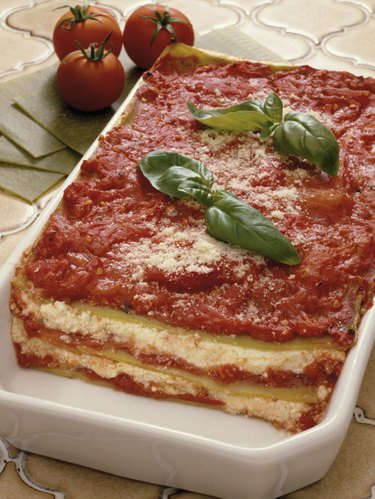
It's hard not to like lasagna, one of the most iconic of pasta dishes. Make it thick or thin, dry or runny, rich with cheese or virtuous with a mound of fresh spinach, however you like it best. It's a preparation-intensive dish, especially when it's made from scratch, so it makes good, pragmatic sense to bake a big batch and keep some in the freezer to thaw for later meals. Within limits, thawed lasagna can even be re-frozen for another occasion.
Looking for Safety
Video of the Day
Worry-free thawing and refreezing starts on the day you make your lasagna. If you follow good food safety practices now, there's less likelihood of problems later. Let the uneaten lasagna cool and begin to firm up, then cut it into meal-sized portions for freezing. The pieces will cool more efficiently in their individual containers than in the original pan. As soon as they're cooled all the way to room temperature, move the portions to your refrigerator or freezer. In total, it should take no more than two hours from the time your lasagna comes out of the oven.
Video of the Day
Chilling Out
Freezing your portions efficiently is the next step toward ensuring food safety. Take care not to stack them, which interferes with rapid cooling. Instead, distribute the portions around your freezer in a single layer. If it's a very large batch of lasagna, divide it and only refrigerate half on the first night. Refrigerate the rest and freeze it the next day, so the warm lasagna doesn't overload your freezer's cooling capacity and put the rest of your food at risk.
Thawing Safely
Thawing your lasagna safely is the most important step in the process, because it can undo all your good work up to this point. The only safe way to thaw frozen lasagna, if you want to refreeze it, is in your refrigerator. This keeps it at a food-safe temperature of 40 degrees Fahrenheit or less during the entire thawing process. If you thaw packaged lasagna under cold water or in the microwave, it should be cooked that day and not refrozen.
Refreezing Your Lasagna
Refreezing your thawed lasagna is as simple as putting it back in the freezer. You don't need to be concerned about overloading the freezer's cooling capacity unless you're refreezing portions totaling several pounds. When you put it back, take care to distinguish the lasagna's packaging with some sort of label or mark. That way you'll know it's been previously thawed and won't thaw and refreeze it a second time. It only increases the risk of food-borne illness slightly, but the repeated thawing and freezing can cause a noticeable loss of quality.
That Quality Thing
A well-made lasagna can usually be thawed and refrozen once without any especially bad effects, but after that you'll begin to notice some undesirable changes. The repeated freezing can make the noodles soft and mushy, and ingredients such as ricotta, cottage cheese and spinach can ooze moisture into the dish. Repeated thawing also dampens the flavors of the pasta. It's still perfectly edible, but it's not nearly as enjoyable as it might otherwise be.